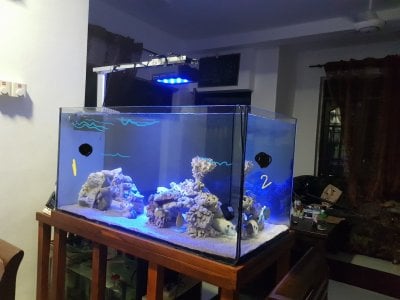

- WHERE TO PLACE WAVEMAKER IN SALTWATER AQUARIUM HOW TO
- WHERE TO PLACE WAVEMAKER IN SALTWATER AQUARIUM UPGRADE
So how many pumps do you need? There is not a one size fits all solution however, the guidelines in the chart below should provide ideal recommendations for most folks. That’s where Detritus (waste) can quickly build up and cause a nutrient explosion if not addressed. Soft Coral AquariumĨ-10x Aquarium Volume Turnover Including Flow from the Return Pumpġ2-20x Aquarium Volume Turnover Including Flow from the Return PumpĢ0-50x Aquarium Volume Turnover Including Flow from the Return Pumpįlow Requirements for Aquarium Types Dead SpotsĪ dead spot refers to an area that doesn’t receive adequate water flow. Placing a powerhead in front or behind the aquascape will minimize the loss of flow versus pumps aimed directly into the rockwork. Generally, SPS corals require the most flow while soft corals demand the least. LivestockĮach coral variety will have different flow requirements. The larger the tank, the more flow you’ll need. Types of Powerheads & Their Flow Tank Size It does a great job of creating surface agitation when placed towards the top of an aquarium. Flow is similar to a wave created by an artificial wave pool.
WHERE TO PLACE WAVEMAKER IN SALTWATER AQUARIUM HOW TO
Aquarium Powerhead TypeĮach type of powerhead has a unique flow pattern that will play a role in determining how to position a particular pump along with how many you need. The following considerations will help determine how many pumps you should purchase. How Many Powerheads Do I Needĭeciding how many wave pumps you need for your system can be difficult. Proper powerhead placement will ensure consistent water movement throughout all parts of the aquarium and help create a healthy and thriving underwater ecosystem. Do not run the pump unless it is in water.Selecting the correct amount of powerheads and placing them in the proper position is more crucial than the type of powerhead you choose. Please refer to the installation method in the figure.Your wavemaker MUST totally submersed into the water. Instead, gently slide the magnet into position. Precautions for use: Because the bottom is a strong magnet, do not place the magnet directly opposite the unit, as it can strike the glass very hard.Small profile so it doesn’t take up much space in the tank. Environmental protection motor avoid pollution to the living circumstance. 360°rotation adjustable and totally submersible and oil-free motor:360°easily adjust the direction of the water flow, no dead angle, Anti-reverse, effectively control overturn, protect the motor from damage.optimize the angle of the propeller, more powerful, constructed of Anti-corrosion titanium impellers, wear-resistant, Suitable for freshwater and saltwater aquariums. increase the shock absorber nail design, reduce vibration, ultra-silence.
WHERE TO PLACE WAVEMAKER IN SALTWATER AQUARIUM UPGRADE
Strong magnetic suction cup, propeller design: new upgrade increases the suction cup, making the adsorption more stable.The wavemaker will allow the tall plants to move fluidly, giving the aquarium a more natural look. Encrypted thickened filter cover and makes strong waves: Durable, reinforced ABS case, with a cover which protects the fish without affecting water intake, simulates the natural currents of rivers or oceans, providing a healthier and more natural like habitat for your fish.At the same time, avoid the accumulation of dirt in the fish tank, which is difficult to clean. Wavemakers counter balance this, distributing oxygen. The water in this area is less oxygenated and can affect the overall balance of your tank. Wavemakers help to circulate the water in your aquarium where is does not typically move. Why need a wavemake pump? To avoid the fish tank’s lifelessness, create waves to increase the fish’s movement, make the fish increase vitality and more beautiful.


 0 kommentar(er)
0 kommentar(er)
